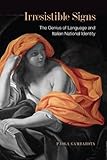Irresistible Signs : The Genius of Language and Italina National Identity / Paola Gambarota.
Material type: TextPublisher: Toronto : University of Toronto Press, [2011]Copyright date: ©2011Description: 1 online resource (368 p.)Content type:
TextPublisher: Toronto : University of Toronto Press, [2011]Copyright date: ©2011Description: 1 online resource (368 p.)Content type: - 9781442642980
- 9781442695269
- 850.9/358
- PQ4053.N29 .G363 2011
- online - DeGruyter
| Item type | Current library | Call number | URL | Status | Notes | Barcode | |
|---|---|---|---|---|---|---|---|
 eBook
eBook
|
Biblioteca "Angelicum" Pont. Univ. S.Tommaso d'Aquino Nuvola online | online - DeGruyter (Browse shelf(Opens below)) | Online access | Not for loan (Accesso limitato) | Accesso per gli utenti autorizzati / Access for authorized users | (dgr)9781442695269 |
Frontmatter -- Contents -- Acknowledgments -- 1 Scripts of Vernaculars and Collective Characters in Early Modern Europe -- 2 Ut Lingua, Natio: Dominique Bouhours’s Genius of the Nation and Ludovico Antonio Muratori’s Italian Republic of Letters -- 3 Giambattista Vico, the Vernacular, and the Foundations of Modern Italy -- 4 Translating Genius: Cesarotti, Ossian, and the Question of National Character -- 5 Towards Sameness: Leopardi’s Critique of Character, and the End of the Nation -- Irresistible Signs? A Postscript and the Question of Media -- Notes -- Bibliography -- Index
restricted access online access with authorization star
http://purl.org/coar/access_right/c_16ec
Language is now understood as a key component of cultural identity, but discourses on linguistic nationalism are only a few centuries old. In Irresistible Signs, Paola Gambarota investigates the connection between Italian language and national identity over four hundred years, from late-Renaissance linguistic theories to nineteenth-century nationalist myths.Challenging the consensus that linguistic nationalism originated with nineteenth century German philosophers, Irresistible Signs advances a more nuanced theory of how culture and language become inextricably linked through literary and rhetorical elements. Gambarota combines Anglo-American theories of the nation with the most advanced Italian scholarship on language ideology and delves into ideas from Giambattista Vico, Giacomo Leopardi, and Melchiorre Cesarotti. Irresistible Signs also explores how images of national communities are represented within vernaculars, affirming their influence in shaping contemporary models of monolingual nationhood.
Mode of access: Internet via World Wide Web.
In English.
Description based on online resource; title from PDF title page (publisher's Web site, viewed 01. Dez 2023)


